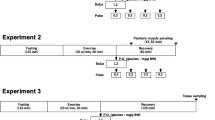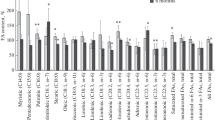Summary
Utilization of carbohydrates and free fatty acids (FFA) has been investigated in gastrocnemii of dogs during long lasting isotonic rhythmical exercise induced by supramaximal stimulation of the sciatic nerve. Uptake or output of gases and substrates was determined according to the Fick principle. The first measurements were done at about 2 min after the beginning of work when blood flow has reached a steady state, and the latest at about 100 min after the beginning of exercise.
During the first 7 min when the work performed exceeded 5 kg/100g×min and O2 consumption exceeded 11 ml/100g×min, uptake of arterial glucose and FFA was low, accounting for less than 40% of the total O2 consumption. Since the RQ values at the same time were about 1.0, glycogen must have been oxidized as the major aerobic energy source.
About 13 min after the beginning of exercise, the work the muscles could perform declined to about half of the initial value and remained so for the following 90 min. During this time the oxygen extraction ratio of FFA was about 50% and of arterial glucose was 40–50%, while the RQ value was about 0.8.
During initial strong exercise an output of lactic acid (LA) of about 10 mg/100 g×min was measured. With the decrease of work as a consequence of fatigue, LA output became negligible, and in many experiments small amounts of LA were taken up by the working gastrocnemii.
It is concluded that glycogen is the major aerobic energy source for strong muscular exercise which cannot be substituted for by the oxidation of arterial glucose or FFA.
Similar content being viewed by others
References
Bartelmai, W., Czok, R.: Enzymatische Bestimmungen der Glucose in Blut, Liquor und Harn. Klin. Wschr.40, 585–589 (1962).
Bing, R. J., Siegel, A., Vitale, A., Balboni, F., Sparks, E., Taeschler, M., Klapper, M., Edwards, S.: Metabolic studies on the human heart in vivo. I. Studies on carbohydrate metabolism of the human heart. Amer. J. Med.15, 284–296 (1953).
Chapler, C. K., Stainsby, W. N.: Carbohydrate metabolism in contracting dog skeletal muscle in situ. Amer. J. Physiol.215, 995–1004 (1968).
Corsi, A., Midrio, M., Granata, A. L.: In situ utilization of glycogen and blood glucose by skeletal muscle during tetanus. Amer. J. Physiol.216, 1534–1541 (1969).
Crane, R. K., Sols, A.: The association of hexokinase with particulate fractions of brain and other tissue homogenates. J. biol. Chem.203, 273–292 (1953).
Diamant, B., Karlsson, J., Saltin, B.: Muscle tissue lactate after maximal exercise in man. Acta physiol. scand.72, 383–384 (1968).
Dole, V. P., Meinertz, H.: Microdetermination of long-chain fatty acids in plasma and tissues. J. biol. Chem.235, 2595–2599 (1960).
Gercken, G.: Die quantitative enzymatische Dehydrierung vonl-(+)-Lactat für die Mikroanalyse. Hoppe-Seylers Z. physiol. Chem.320, 180–186 (1960).
Hirche, Hj., Biebrach, M., Grün, D., Müller-Ruchholtz, E. R., Waller, W.: Arbeitsfähigkeit und Glykogengehalt des Skeletmuskels. Pflügers Arch.312, 95 (1969).
—, Langohr, H.-D.: Die arteriovenösen Differenzen der gesamten und der einzelnen freien Fettsäuren am Herzen, am Skeletmuskel und an der Niere bei verschieden hoher arterieller Konzentration. Z. ges. exp. Med.146, 67–82 (1968).
—, Raff, W. K., Grün, D.: The resistance to blood flow in the gastrocnemius of the dog during sustained and rhythmical isometric and isotonic contractions. Pflügers Arch.314, 97–112 (1970).
—, Vollmer, U. J.: Der Substratumsatz des Skeletmuskels bei unterschiedlicher Arbeitsleistung. Pflügers Arch. ges. Physiol.297, R75 (1967).
Hultman, E.: Studies on muscle metabolism of glycogen and active phosphate in man with special references to exercise and diet. Stockholm: Tryckeri Balder AB, 1967.
Keul, J., Doll, E., Keppler, D.: Muskelstoffwechsel. Die Energiebereitstellung im Skeletmuskel als Grundlage seiner Funktion. München: Joh. Ambr. Barth, 1969.
Kramer, K., Quensel, W., Schäfer, K. E.: Untersuchungen über den Muskelstoffwechsel des Warmblüters. IV. Mitteilung. Beziehungen zwischen Sauerstoffaufnahme und Milchsäureabgabe des Muskels während der Tätigkeit. Pflügers Arch. ges. Physiol.241, 730–740 (1939).
Lamb, D. R., Peter, J. B., Jeffress, R. N., Wallace, H. A.: Glycogen, hexokinase, and glycogen synthetase adaptation to exercise. Amer. J. Physiol.217, 1628–1632 (1969).
Leuthardt, F.: Lehrbuch der Physiologischen Chemie. Berlin: W. de Gruyter & Co. 1961.
Miller, H. I., Gold, M., Spitzer, J. J.: Removal and mobilization of individual free fatty acids in dogs. Amer. J. Physiol.202, 370–374 (1962).
Paul, P.: FFA metabolism of normal dogs during steadystate exercise at different work loads. J. appl. Physiol.28, 127–132 (1970).
Piiper, J., di Prampero, P. E., Ceretelli, P.: Oxygen consumption and mechanical performance of dog gastrocnemius muscle with artificially increased blood flow. Pflügers Arch.311, 312–325 (1969).
———: Oxygen debt and high-energy phosphates in gastrocnemius muscle of the dog. Amer. J. Physiol.215, 523–531 (1968).
P. E. di Prampero, Ceretelli, P., Piiper, J.: Lactic acid formation in gastrocnemius muscle of the dog and its relation to O2 debt contraction. Respirat. Physiol.8, 347–353 (1970).
———: O2 consumption and metabolic balance in the dog gastrocnemius at rest and during exercise. Pflügers Arch.309, 38–47 (1969).
Stainsby, W. N., Welch, H. G.: Lactate metabolism of contracting dog skeletal muscle in situ. Amer. J. Physiol.211, 177–183 (1966).
Whelan, W. J., Cameron, M. P.: Control of glycogen metabolism. Ciba foundation symposium. London: J. & A. Churchill 1964.
Whipp, B. J., Wasserman, K.: Efficiency of muscular work. J. appl. Physiol.26, 644–648 (1969).
Author information
Authors and Affiliations
Additional information
Supported by the Deutsche Forschungsgemeinschaft.
Rights and permissions
About this article
Cite this article
Hirche, H., Grün, D. & Waller, W. Utilization of carbohydrates and free fatty acids by the gastrocnemius of the dog during long lasting rhythmical exercise. Pflugers Arch. 321, 121–132 (1970). https://doi.org/10.1007/BF00586367
Received:
Issue Date:
DOI: https://doi.org/10.1007/BF00586367




